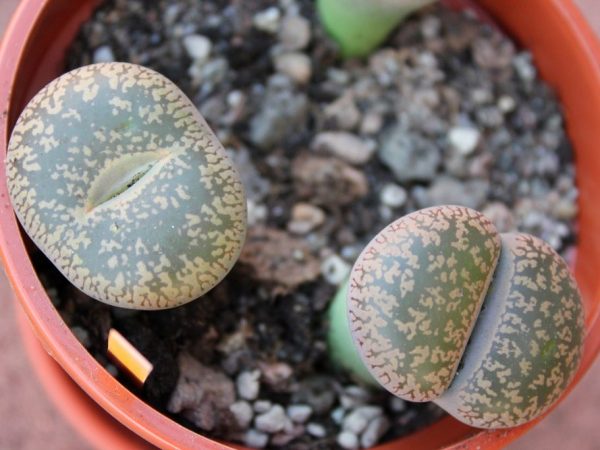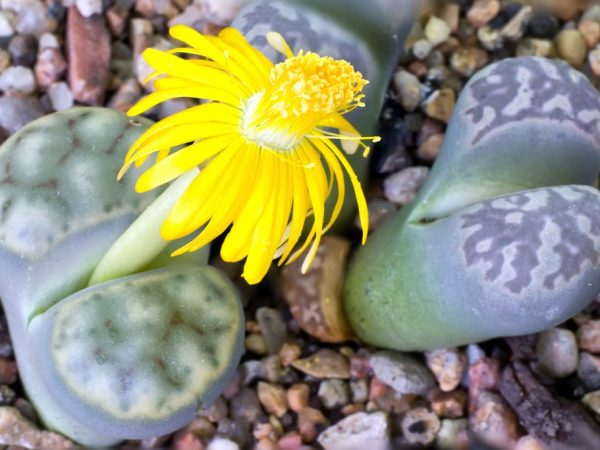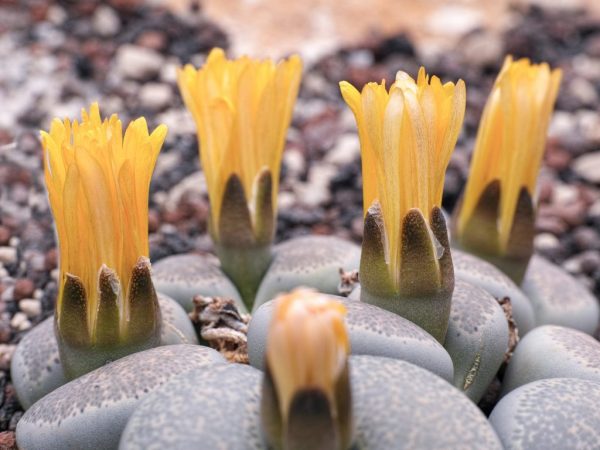Lithops, or flowering stones - tips for growing
Lithops are succulents native to the rocky deserts of South and Southwest Africa. Today, different varieties of these plants adorn the most modern interiors around the world.

Lithops, or flowering stones - tips for growing
Discovery history
These strange plants are called "living stones". In order not to get anyone's food, lithops are disguised as pebbles.
This species was found in 1811 by the English botanist Burchell, who sat down to rest while traveling in the desert. He found a pile of pebbles next to him. While trying to pick up a pebble, he was surprised to notice its roots. On closer inspection, he saw plants, in color and shape, completely similar to inanimate minerals and having a small size.
Botanical description
Lithops are perennial succulents that look like flat pebbles split in two and store water in their fleshy short leaves. They cannot be confused with a cactus, but from the outside it is difficult to call them plants at all.
They grow on quartz and calcareous soils and even on rocks. They are small in size, which is typical for desert inhabitants.
In nature, they find it difficult to obtain water in arid climates, so their leaves are short to survive in the scorching sun, and their roots are long, which allows them to extract moisture from the deep layers of the soil.
The aerial part is small - the length and width often do not exceed 2-5 cm. The closed leaves resemble a hoof due to the transverse cut.
Interesting fact! Lithops have different types of roots: some for nutrition, while others are contractile, pulling the plant into the ground during a drought.
The stem is short, inside and invisible. Thick leaves can be of various colors (from light to blueberry, from monochromatic to patterned), almost round in shape, due to which the evaporation of moisture is minimal.
Flowering features
Surprisingly, even in the desert you can see "living stones" in bloom.
Flowering begins during the rains, lasts for two weeks and has its own cycles: the buds fully open from noon and close before sunset.
Flowers up to 3 cm in diameter, they are larger than the leaves, and resemble chamomile. The color of the petals can be yellow or white, but after five days it changes under the influence of the sun. White flowers turn pinkish, and yellow flowers turn brick.
Lithops have annual growth cycles that depend on the amount of light and rainfall throughout the year.
- They don't grow in summer.
- In autumn, growth and flowering begin, seeds are formed.
- In winter, with a small amount of light, new leaves appear, and the old wrinkled ones die off in the form of a kind of skin (the so-called molting occurs) in order to store water in the already new leaves in the spring.
Note! The closest relative of lithops is "living granite" or pleiospilos.
Varieties
About 40 species of Lithops have been found in nature, but only 15 are available for cultivation at home.
The collections of florists consist of specimens of various shades that are used for breeding and creating new species. It is by their color that ordinary plant lovers distinguish them.
Types of Lithops:
- Aucamp (lithops aucampiae). The aukamp variety has a fairly standard grayish-greenish color with furrows on the leaves. Flowers up to 4 cm, yellow.
- Leslie (lithops lesliei). The Leslie variety stands out for its very short leaf blades with a fine marble-like pattern. The color is gray-blue. The flowers are white, fragrant.
- Marble (lithops marmorata). A green-grayish plant with a patterned surface reminiscent of velvet. The flowers are large - up to 5 cm.
- Leslie marie (lithops lesliei mariae). Brownish-yellow "pebbles" with a shallow crevice and a dark pattern.
- Optics (lithops optica). They have purple leaves, grow only up to 3 cm. They resemble blueberries.
Purchase and adaptation

Lithops grow very slowly
When buying, it is recommended to choose adult lithops, as they grow slowly.
If you decide to buy seeds, pay attention to the names of the varieties, but to create a colorful composition it is better to purchase a mix from the Gavrish company (d5 - diameter 5), which includes different species. The price, on average, is small and often does not exceed 50 rubles for 5 seeds.
When choosing a plant, you need to inspect and make sure there are no spots or rot. Even minor mechanical damage can be fatal.
Next, you should swing the "pebble" - it should sit firmly in the substrate, which indicates a well-developed root system. The leaves, in turn, should be dense.
Special adaptation after purchase is not required - it is recommended only to transplant new pets to another land and not water the first days.
Landing
Lithops should be planted in small pots with a height of 10 cm, because they have a developed root system, which tends to go down as deep as possible.
Note! Too much capacity for a small root system will rot. It is recommended to choose wide bowls, and the soil should pass air and moisture well.
Plants are planted in groups, otherwise "loners" may die. You can combine them in the same pot with other succulents, for example, cacti, or add to the composition in the greenhouse of the schizobasis.
When planting, it is important not to damage a large root, but thin roots grow quickly and soon fill the entire space.
Growing conditions
It is worth placing a pot of lithops closer to the window or organizing lighting with phytolamps. South facing sills work best. During warmer months, you can take the pots out into the fresh air or on the balcony.
In nature, lithops settle on rocky lands, so a similar soil is needed for cultivation.
The soil should not contain a lot of humus or retain water. For these purposes, the soil for cacti is mixed with perlite and sand (1: 2), and chalk is also added to lower the acidity indicators.
Decorative stones in a pot will not only decorate the composition, but also help maintain the microclimate of the substrate.
The content implies dry air - excess moisture will lead to death. Spraying is prohibited.
Temperature
In the desert, the temperature changes sharply twice a day - from warm to cold, so such fluctuations will not harm the plants. They tolerate heat well and feel great at a temperature of 22-25⁰С. In winter, you can lower these indicators to 12 ° C, but not lower than 7 ° C.
Note! In the bright sun, overheating is possible, since under natural conditions the roots go deep into the cool ground, but this cannot be achieved in small pots.
Lighting
At home, you will also have to maintain a high level of lighting, otherwise the lithops may die.
At least 4 hours of direct sunlight and at least 12 hours of artificial lighting are required daily.
Fluorescent lamps are placed at a distance of 15 cm from the plants.
Care

Plants will decorate your interior
A novice florist can also grow pebbles - care will be even easier than for other plants, despite the fact that this genus is represented by desert succulents.
Fertilizers and feeding
Top dressing is often not required. Complex fertilizers are used only for specimens that have not been transplanted for a long time (from two years).
The additives are mixed with water and applied twice a year - at the beginning and end of the growing season. For this, fertilizers for cacti are suitable, only in a dosage diluted twice.
Watering
Succulents grow in arid places, they store water well and are not used to excessive moisture, so the soil should dry out completely.
In winter, watering stops altogether and decreases during flowering, but during the growth period, it is enough to water the flowers abundantly once every two weeks or a month.
If you accidentally poured too much water, then you need to drain the excess liquid from the pan. Drops must not be allowed to fall on the above-ground part. A great way is to pour water into the sump and drain off after 15 minutes.
Transfer
The procedure is carried out in case of emergency, as a rule, it is carried out every 3-4 years. In this case, you need to try not to hurt a large root.
Only those specimens with which the pot has become small should be transplanted. To understand that the time has come, you need to see whether or not the root system has filled the entire capacity.
The pot should not be flat or very large. Expanded clay is placed at the bottom, and then new soil, which must be disinfected in advance. Lithops should not be watered for several days before and after transplantation.
Additional recommendations
A few rules to help you grow "desert stones":
- When flowers appear and buds are laid, it is undesirable to rotate the pot relative to the sun - constant orientation is important.
- Lithops need regular ventilation, otherwise rot may form.
- From autumn to spring, a dormant period lasts, the end of which is evidenced by the appearance of new leaves and the wilting of old ones.
- Atrophied leaves in the form of a dried film do not need to be removed by force.
- Slow growth allows the composition to persist for many years.
Reproduction methods
Reproduction of lithops from seeds is more common, but they can be grown from cuttings much faster, since "living stones" grow rather slowly.
Seeds
Seed propagation is simple and economical. For this you need:
- Buy a bag of seeds - be guided by the names, as they often sell a mix that includes different types;
- Sow seeds in a suitable pot - shallow, with holes. The soil is standard. We sow into a moist substrate at some distance, sprinkle on top with a thin layer of sand.
- The container is closed with a transparent lid or foil and placed on a sunny windowsill or under lamps.
- You need to immediately water the plantings a little through the pallet or by spraying. The earth must not be allowed to dry out.
- Seedlings appear unevenly within two weeks. After a couple of weeks, it is necessary to reduce the moisture content of the soil. After that, good lighting should be organized.
- The foil or lid is lifted daily for ventilation.
Growing from seed takes a long time, and the first flowering can only be seen after 3 years. Young "stones" can fall on their side due to insufficiently strong roots - they should be supported with toothpicks.
Cuttings
Perennial plants will have many shoots - leafy ones can be rooted, but stem ones will die during transplantation.
Cuttings are cut during growth but not flowering.The cut site is dried and disinfected, and the scraps are dried for a week, and then buried in the substrate with a cut down to half the height.

Leafy cuttings can be taken for propagation
You can water the cuttings a little after a week. The first roots will grow back only after a month. After that, you need to establish normal care.
By dividing an adult plant
Lithops should be propagated by division at the beginning of autumn, when the leaves grow as much as possible. To do this, the plant is cut vertically with a sharp blade or knife, the cut site is dipped in crushed activated carbon for disinfection.
It is important not to damage the main root. Further, new specimens should be planted in pots at the usual depth. At the end, it is recommended to water and maintain normal maintenance.
Diseases and pests
Lithops are rarely affected by pests, and the main problem is rot due to excessive watering, lack of light and ventilation.
| Disease | Signs | Treatment | Prophylaxis |
| Putrefaction | The root and aerial part are covered with dark spots, the leaves soften or swell. | Transplant the plant, adjust the care. A transplant is required if the roots are damaged. In other cases, the damaged part is cut off with a knife and sprinkled with activated carbon for disinfection. | Proper care of lithops at home allows you to avoid most diseases. |
| Mushroom mosquito, worm | Leaf curl, visible insects, spots and white coating, damage to the skin of the leaves. | Watering the soil with a weak solution of potassium permanganate, drying the soil. Spraying leaves with insecticides or washing with soapy water. |
For busy people and those who do not like hassle, flower growers are advised to decorate the house not with a banal cactus, but with exotic lithops, the maintenance of which at home does not require excessive attention. You can forget about them even for a couple of months, and the plant composition itself grows well and will still be pleasing to the eye.

